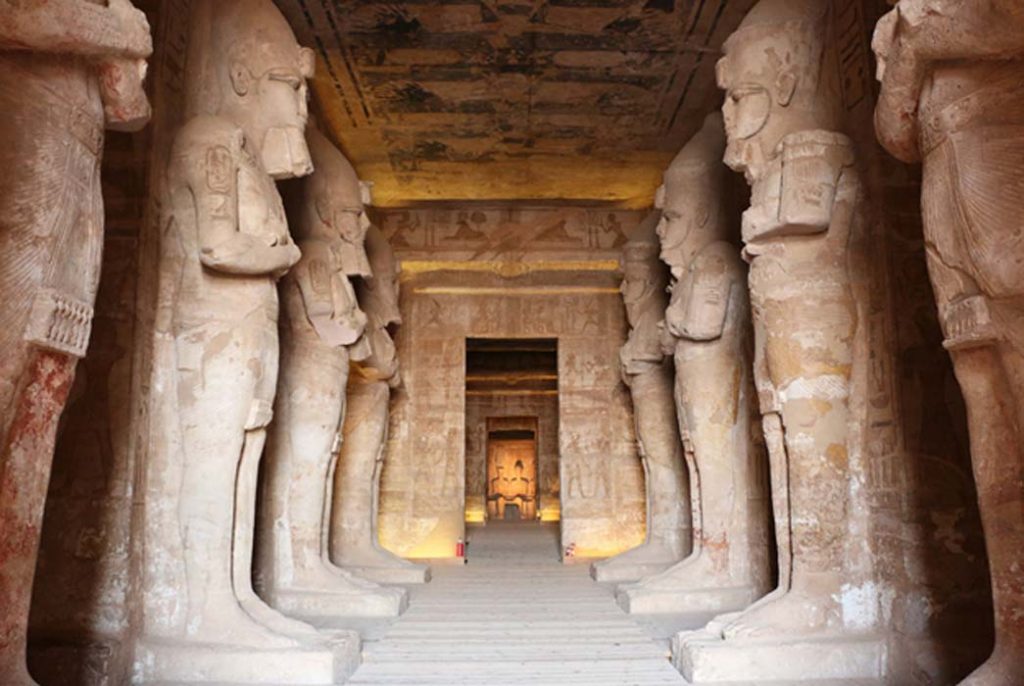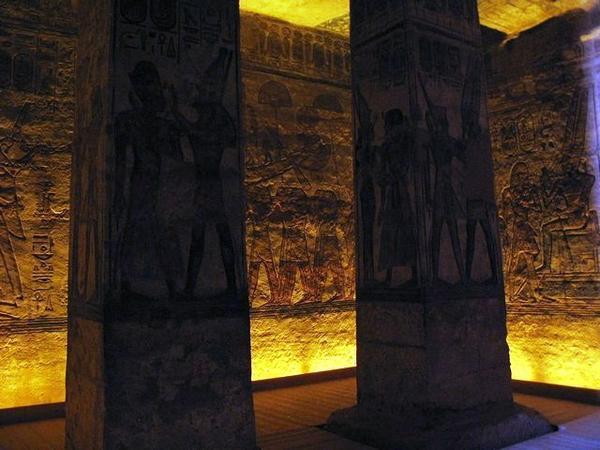
The Great Temple of Ramses II is one of the most fantastic places in the world which is classified as a world heritage by the UNSECO. It was built by Ramses II who dedicated it to the national gods of Egypt: Ptah, Ra, Amun, and himself, Ramses II as a deified king, son of Ra. Besides Karnak, this is the most impressive temple in Egypt not only because of its façade with the four colossi of the pharaoh, but also because of the place itself. The temple seems to be standing lonely in far Nubia, contemplating the sunrise that emerges from the waters of the lake of Nasser, surrounded by the immense desert which seems to be of other epoch and other planet. Construction of the temple began in approximately 1244 BC and lasted for about 20 years. Being Known as the "Temple of Ramses, beloved by Amun", it was one of six rock temples erected in Nubia during the long reign of Ramses II. The facade of the main temple is 32 meters high and 38 meters wide. It is occupied mainly by the four Ramses II colossi, each measuring almost 20 meters, representing him in his throne. At his feet, we can see his wife, his mother and his sons. In the middle of the façade, above the gate, he makes offerings to Ra-Hor-Akhti consisting of a scepter and the feature of justice, Maat, both together with the image of Ra-Hor-Akhti form User-Maat-Ra or the name of Ramsés II himself!. 22 baboons, intended to be 24 at the beginning, represent the 24 hours of the day saluting the rising Ra, while beneath, there are all the titles of Ramses II as a god and king of Upper and Lower Egypt: Horus, The Strong Bull, etc. In the entrance, on both bases of the colossi, we can see the traditional scene of the Nile god -Hapi- tying the lotus and the papyrus as a symbol of unifying Egypt, and beneath him, there are submitted Africans and Asiatic prisoners .
- The Grand Hall of the Great Temple of Abu Simbel

The Grand Hall of the Great Temple of Abu Simbel houses eight pillars with Osiriform (mummy form) statues, four on each side, imitate the traditional Hypostyle hall in the built temples. The statues represent Ramses II holding the scepter and the whip as symbols of power and authority. On the right side, he wears the Double Crown, while on the left side, he wears the Upper Egypt Crown only, may be, because the temple was caved in the rock and it was difficult to reproduce in the stone the hollow shape of the Lower Egypt Crown. In the ceiling, and still in fresh colors, we can see Nekhbet -the vulture- protecting and blessing the building. The walls on both sides have scenes that depict different incidents, all full of life: the battle of Kadesh, the siege of the city, and the captives procession. On both sides of the hall, there are also small rooms that were used as storerooms.
The Second Hall of The Great Temple of Abu Simbel

The Second Hall of The Great Temple of Abu Simbel includes four rectangular pillars, cut in the rocks, painted with still-remaining vivid and fresh colors. They are decorated with scenes of Ramses II crowned and blessed by gods of Egypt, while on the walls, Ramses II appears, accompanied by his wife, Queen Nefertari, worshiping the Bark of Amon-Ra, Min, Ptah, Ra-Hor-Akhti, etc. In the upper register of the walls and the pillars, cobras and a number of Royal Cartouches are reproduced.
The Sanctuary of the Great Temple of Abu Simbel
In the Sanctuary of the Great Temple Ramses II at Abu Simbel, we can see statues of the four national gods of Egypt: Ptah (the obscure god of Memphis), Amun (god of Luxor), Ramses himself deified and Re-Horakhty (the union of Ra and Horus). A solstice occurs twice a year on February 20-22nd and on October 20-22nd. On the sunrise, the light enters 60 meters inside the temple to illuminate the faces of Amun, Ramses and Ra, but never the face of Ptah. In fact, this phenomenon used to occur two days before these dates, but after the relocation of the temple, the dates changed.
Around the Great Temple of Abu Simbel

On both sides of the Great Temple of Ramses II at Abu Simbel, we can see two small chapels and on the left side, there are three stelae. The most important stela tells about the marriage of Ramses II to the daughter of the king of the Hittites after signing the peace treaty with him.
